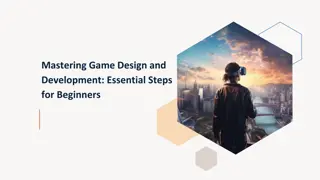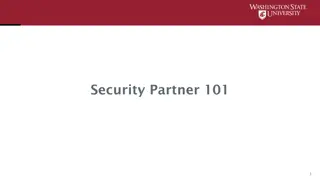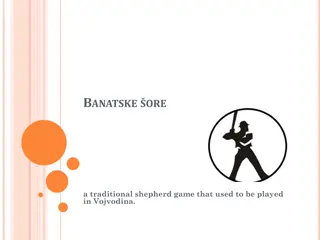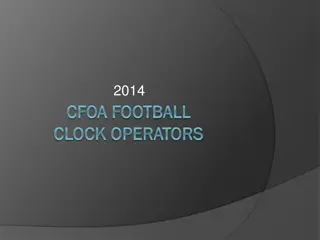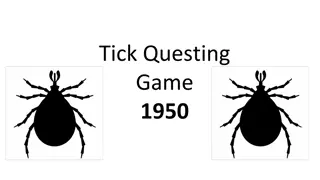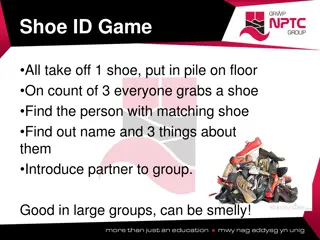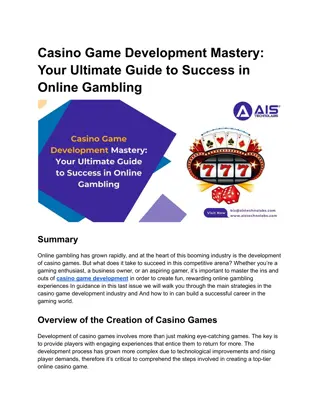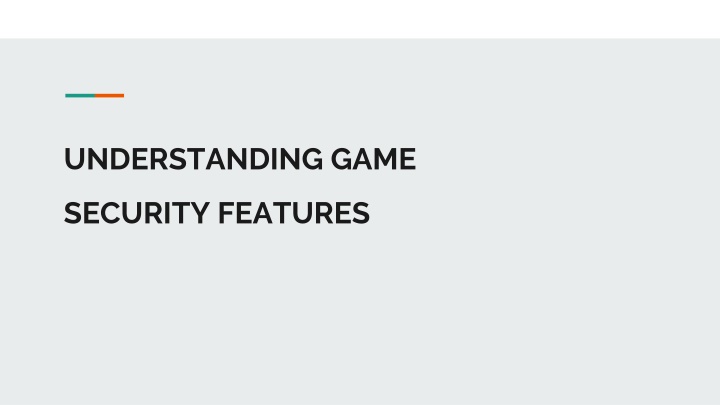
Game Security Features and Anti-Cheat Systems
Explore the importance of game security measures, trends in online gaming, impact of security breaches, and the implementation of robust security measures. Learn about anti-cheat systems like Easy Anti-Cheat (EAC) and Valve Anti-Cheat (VAC) and the tactics they employ to ensure fair gameplay.
Download Presentation

Please find below an Image/Link to download the presentation.
The content on the website is provided AS IS for your information and personal use only. It may not be sold, licensed, or shared on other websites without obtaining consent from the author. If you encounter any issues during the download, it is possible that the publisher has removed the file from their server.
You are allowed to download the files provided on this website for personal or commercial use, subject to the condition that they are used lawfully. All files are the property of their respective owners.
The content on the website is provided AS IS for your information and personal use only. It may not be sold, licensed, or shared on other websites without obtaining consent from the author.
E N D
Presentation Transcript
UNDERSTANDING GAME SECURITY FEATURES
Game Security: What It Is and Why It Matters Game security refers to the set of measures, practices, and technologies designed to protect video games and their associated infrastructure from various threats. Protects players from cheats, hacks, and harassment, Secures In-Game Transactions,Compliance with Regulations Safeguards player data and accounts Maintains a fair, enjoyable environment
Current Trends in Online Gaming Growth of Mobile Gaming Expansion of Cloud Gaming Increased Focus on Virtual Reality (VR) and Augmented Reality (AR) Integration of Blockchain Technology Continued Development of Live-Service Games
The Impact of Security Breaches Cheating Account Hacking Data Theft DDoS Attacks (Distributed Denial of Service) Malware and Viruses
IMPLEMENTING ROBUST SECURITY MEASURES AT BOTH DEVELOPER AND CLIENT ENDs
Anti-Cheat Systems Anti-cheat systems are software solutions designed to detect and prevent cheating in online games, ensuring a level playing field. These systems detect and penalize players using unauthorized tools or modifications for unfair advantages, like wallhacks or aimbots or speeding up gameplay
Easy Anti-Cheat (EAC) and Valve Anti-Cheat (VAC) EAC is a proprietary anti-cheat service developed by Kamu, designed to detect and prevent cheating in online multiplayer games. EAC is used in many popular games such as Fortnite, Apex Legends, and Battlefield. Valve Anti-Cheat (VAC) is an anti-cheat system developed by Valve Corporation designed to detect and prevent cheating in online multiplayer games, particularly those available on the Steam platform. It is integrated into several popular online games developed by Valve, such as Counter-Strike,Dota 2 and Team Fortress 2.
Tactics Employed by EAC and VAC Signature-Based Detection and Memory Scanning(EAC AND VAC) Driver Monitoring(EAC AND VAC) Behavioral Analysis(EAC AND VAC) Kernel-Level Anti-Cheat(EAC AND VAC) File Integrity Verification(VAC) Server-Side Verification and Monitoring(VAC) Delayed Bans(VAC) Community Reporting and Analysis(EAC AND VAC)
Data Encryption and Security Purpose: Protects player data, including personal and payment info
Cutting-Edge Techniques in Data Security SSL/TLS and AES Encryption End-to-End Encryption Hashing Functions Data Masking
Authentication and Access Control Authentication is the process of verifying the identity of a user, device, or system before granting access to resources. It ensures that only authorized users can access certain data or functionalities. Access control determines what authenticated users are allowed to do within a system. It defines permissions and restrictions for users based on their identity and roles.
INNOVATIVE APPROACHES TO AUTHENTICATION Username and Password Two-Factor Authentication (2FA) Multi-Factor Authentication (MFA) Single Sign-On (SSO)
Access Control Strategies Discretionary Access Control (DAC) Mandatory Access Control (MAC) Role-Based Access Control (RBAC) Attribute-Based Access Control (ABAC)
Digital Rights Management (DRM) Purpose: DRM involves various technologies and practices designed to prevent unauthorized use, copying, and distribution of digital games.
DRM IMPLEMENTATION TECHNIQUES Online Activation Serial Keys Account-Based DRM Periodic Authentication Hardware Locking
Server and Network Security Goal: Server and network security are crucial components of game security that protect the infrastructure hosting games and the data being transmitted between players and game servers.
Protocols for Server and Network Security DDoS Protection and Firewalls Intrusion Detection Systems (IDS) and Intrusion Prevention Systems (IPS) Continuous Monitoring and Logging
Player Behavior Monitoring Purpose: Detects and discourages toxic or disruptive behavior
Player Behavior Monitoring techniques Statistical Analysis Machine Learning Algorithms and Real-Time Monitoring with AI Behavioral Profiling Community Reporting Systems
Secure In-Game Transactions Goal: Secures purchases of in-game items or currency
Protocols for Secure In-Game Transactions Tokenization Multi-Factor Authentication (MFA) Fraud Detection and Prevention API Security
Regular Updates and Patching Purpose: Fixes vulnerabilities and enhances security
Best Practices for Regular Updates and Patching Scheduled Patch Releases Hotfixes for Critical Vulnerabilities Automatic Updates Incremental Updates Forced Updates for Multiplayer Compatibility Third-Party Library Updates
Education, Player Awareness and Ethics Goal: Encourages players to protect themselves Tips: Awareness of Security Risks(like forums and official game websites), Encouraging Strong Account Security Fostering Safe Online Behavior Staying Informed on Security Best Practices Promoting Responsible In-Game Transactions Player Privacy, Fairness and Equity, Responsibility in Design




